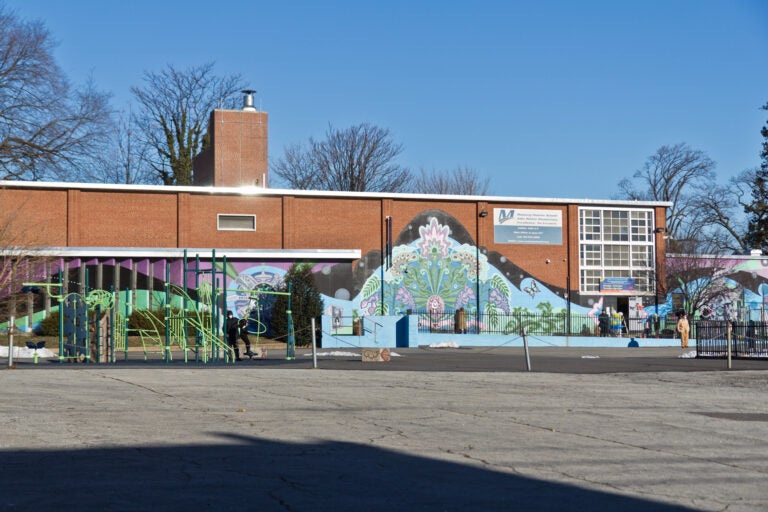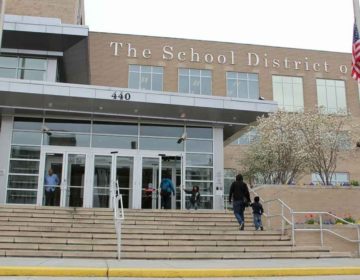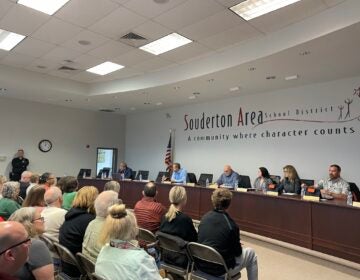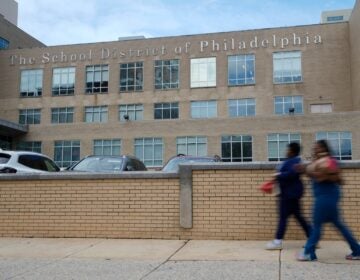With teacher departures surging, Philly schools unveil plan to stem tide
So far this school year the School District of Philadelphia has seen an unusual uptick in teachers leaving. And vacancies are going unfilled.

File photo: John Wister Elementary School in Philadelphia’s Germantown neighborhood on March 3, 2021. (Kimberly Paynter/WHYY)
The School District of Philadelphia, like other districts across the nation, is facing a teacher and staff shortage as the coronavirus pandemic hits the two-year mark.
At Thursday evening’s school board meeting, district officials put a number on the staffing challenge, while board members approved two measures aimed at addressing the problem.
At the start of the school year, the teacher fill rate was 98%, “which is just slightly below where we normally start, but was a really strong start,” said Larisa Shambaugh, the district’s chief talent officer.
But over the last several months, an unusually large number of teachers have left.
One hundred sixty-nine teachers resigned between Dec. 1 and Feb. 15, substantially more than in the previous three school years. Fifty-seven teachers resigned during the same period in 202-21, 93 in 2019-20, and 122 in 2018-19.
Another 178 teachers are currently on leave or sabbatical, Shambaugh said, and the teacher fill rate has dropped to 96.5%.
Some positions have been particularly hard to fill, including special education, math, science, and English as a Second Language. Elementary school and English positions are not typically hard to fill, Shambaugh said, but have also been a challenge this school year.
Teacher vacancies are not spread evenly across the district. The fill rate is above 95% at the majority of schools. A little more than 50 have a fill rate between 85-94%, while seven schools have a fill rate below 85%.
Teacher absences — and requests for substitute teachers — are higher than in previous school years, and the average daily substitute fill rate is 42%, “which is a dramatic decrease of 42 [percentage points] from what our average fill rate was in years’ past,” Shambaugh said.
Other staffing levels are down. The fill rate for school climate staff is around 85%, compared to previous rates in the mid to low 90s. The fill rate for school nurses is 89.4%, compared to fill rates between 97.1% and 97.8% during the previous three years.
The district has hired 32 nurses since August, but others have left, Shambaugh said. “Our fill rate has not improved since the beginning of the year and, in fact, has gone down a little bit,” Shambaugh explained
Earlier this year, the state set up a student loan relief program for nurses, aimed at keeping them in the profession during the pandemic. Shambaugh hopes that can help with retention.
Shambaugh said the district has already taken some steps to address the teacher shortage, like identifying dozens of schools where teachers will receive up to $5,000 in retention bonuses. Other plans are in the works, like reimbursing teachers for the cost of state permits and certifications.
One key way to tackle the shortage, she said, was creating new pipelines for paraprofessionals to become teachers — a proposal presented to the board at Thursday’s meeting.
“An impactful way to improve teacher diversity”
The Paraprofessional Career Development program, which was jointly developed with the Philadelphia Federation of Teachers, enables paraprofessionals to obtain their teacher certification — or move in that direction — without paying tuition. Paraprofessionals serve as instructional assistants or provide additional support services to students, but are not certified classroom teachers.
The board approved two measures that established partnerships with local universities.
The first, which creates a partnership with Drexel University, is geared toward paraprofessionals with a bachelor’s degree and a 3.0 GPA or higher. They will complete a year-long teacher residency program to get their K-6 teacher certification.
The second measure provides pathways for other paraprofessionals.
College Unbound will offer a program for those with little or no college experience to “begin their pathway to attaining a higher degree,” according to the proposal.
Cheyney University’s program targets paraprofessionals with at least 45 college credits, who want to return to school, complete their degree, and obtain a teaching certification.
LaSalle University will offer a program for paraprofessionals who obtained a bachelor’s degree but have a GPA below 3.0. Those who complete the year-long program will be able to get a K-6 teaching certification.
Ahead of the board meeting, PFT president Jerry Jordan released a statement in support of the program.
“I am simply thrilled that this program is moving forward because I truly believe that it can be an historic step towards equity and justice,” Jordan said. “The majority of paraprofessionals in our District are Black and brown women, and it should be lost on no one that they are some of the lowest paid workers in the system.”
He added that teacher diversity is “sorely lacking” in the district. “Ensuring that we provide the resources needed for paraprofessionals to transition to teachers will be an impactful way to improve teacher diversity,” Jordan said
Shambaugh also acknowledged the need for a new teacher pipeline.
Forty-five percent of the district’s new hires are graduates from a school of education, she said, but Pennsylvania has seen a 65% decline in the number of graduates of traditional teacher preparatory programs over the past decade, and only 14% of graduates from “teacher prep coursework identify as teachers of color.”
Much of the funding for the new programs will come from the American Rescue Plan, a federal COVID relief package.
A need for state-level action
Lawmakers across the country are rewriting rules to address teacher shortages. Last month, California Gov. Gavin Newsom issued an executive order that speeds up the hiring process for short-term substitute teachers and removes barriers that might prevent retired teachers from returning to the classroom. In Kansas, the state board of education lowered requirements for substitute teachers, so that they only need a high school diploma. Both measures are meant to be temporary.
At Thursday’s meeting, board member Mallory Fix Lopez brought up a number of statewide, staffing-related bills she hopes become law this spring. They include a teacher reciprocity bill that would make it easier for teachers who are certified in other states to start teaching in Pennsylvania, and a loan forgiveness act that would forgive up to $40,000 in student debt for teachers who work in Pennsylvania schools for at least four years.
“We know we need new state-level policies and funding to address both short-term and long-term staffing challenges,” she said, adding that lawmakers also need to address “current shortages and pipeline issues related to other essential positions like nurses and bus drivers.”
A push for civic engagement
On Thursday the board also passed the Student Voter Education and Registration Resolution, declaring that SDP “must ensure that all students have access to an education that teaches and promotes the importance of civic engagement and voter registration”
The district already serves as a designated voter registration agency, provides a voter education curriculum, and pays for a staff member at each high school to serve as a “Voter Champion,” helping students register to vote once they become eligible.
But the resolution solidifies its commitment to ensuring that all 18-year-olds across the city register to vote and formalizes efforts to promote civic engagement.
Ibtihal Gassem, an 11th grader at Central High School and member of Pa. Youth Vote, spoke in favor of the resolution before it passed. She said many of her peers are not taught how voting affects them and how they can participate.
“People say that voting is powerful, that your voice has value, but how can us, as young people, understand the significance voting holds if we’re not given the opportunity to,” she asked.
“Education leads to an understanding of the importance of voting. We will learn that it does have an impact on us.”

Show your support for local public media
WHYY is your source for fact-based, in-depth journalism and information. As a nonprofit organization, we rely on financial support from readers like you. Please give today.









